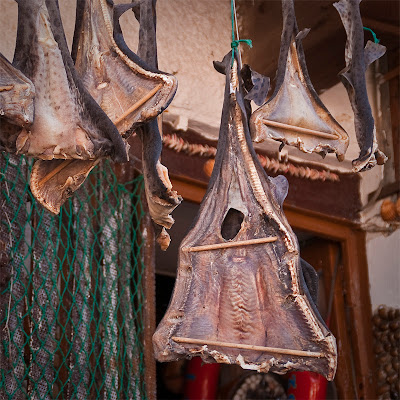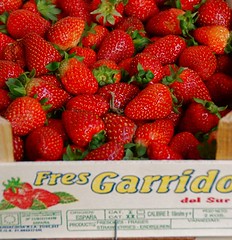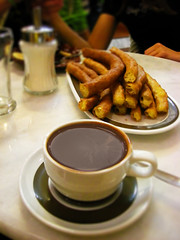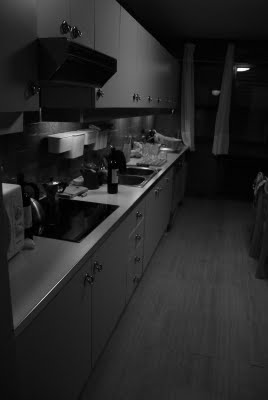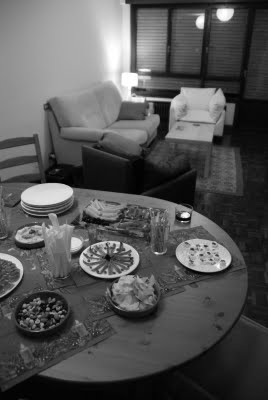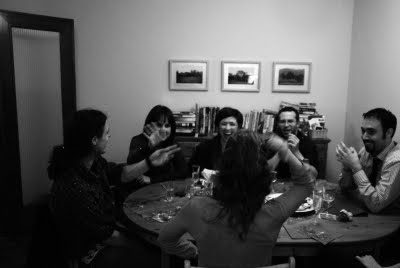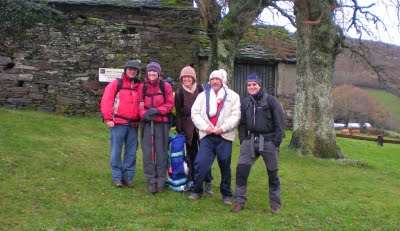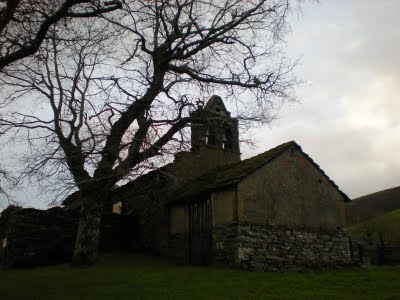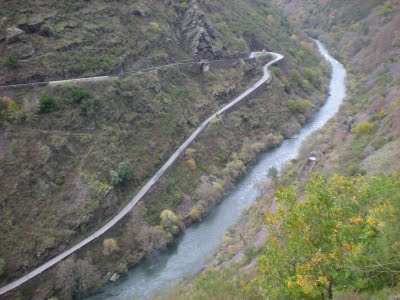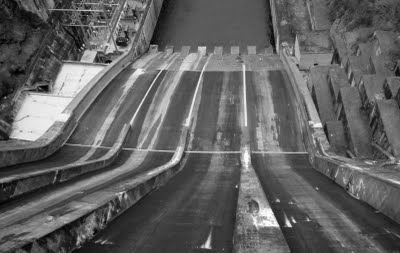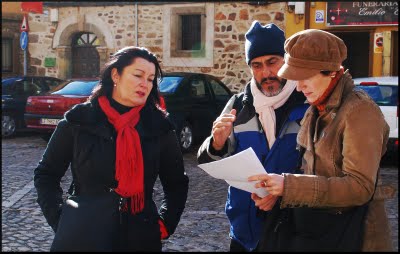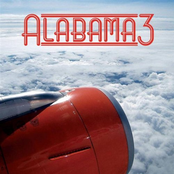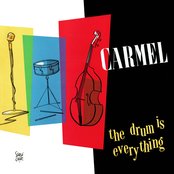
Tombs for one, or granaries
En castellano
It dawned fresh on the crossroads and we headed to the bar for the breakfast of champions. Unfortunately this is Spain so we settled for Madeleines (well Julio and Liz did, I opted for pre-packed sugary doughnuts). A lady from the hotel drove us back to our spot in a big old wobbly estate car that juddered from side to side independently of the camber on the road.
The plan for the day was to walk to Merlán. We had stopped planning in detail thanks to the loss of the guide book so we were relying on a leaflet we had picked up the previous day in the parish of San Lazaro. We didn’t actually know if there was an albergue in Merlán but the second part of the plan was to walk until we came to somewhere to eat or to stay.
So we walked, passing through tiny villages and one-house hamlets and hórreos. In Galicia the hórreos are stone built, with either air bricks or wooden slats in the side, they look like individual sized tombs (I guess you could stack four in if you tried). We stopped facing one as a couple of old ladies paced slowly past. We asked if there had been many pilgrims along today. ¡Ay muchos! Muchos, they replied.

From Lugo to A Coruña en llanto
While we were sitting there another woman came past with a big tub of milk which she proceeded to feed to a calf in a building we had thought deserted. We exchanged pleasantries –Life in the countryside is hard, she said, lots of work, up early, hard work. We made sympathetic noises.
We kept going, hoping for a bar to top up in. Nothing. We talked to one woman who pointed us towards the casa de remedios (basically a private house in which they will sell stuff to pilgrims) but when we got there no one answered Julio’s increasingly despairing cries of !Oiga¡ ¡Hay alguien! and ¡Remedios! (Hellooooo! Anybody there! Foooooood!) One old boy said that we’d find a bar in Seixas. At that point we realised we were in Merlán and we would be walking much further than we thought. In Seixas there was an albergue rather than a bar. Julio and Liz had pulled ahead of me (I was dawdling) and as I approached I could see that the albergue was new. So new in fact, that they were taking delivery of the beds. Great, I thought, we can stop here and have an easy day of it.
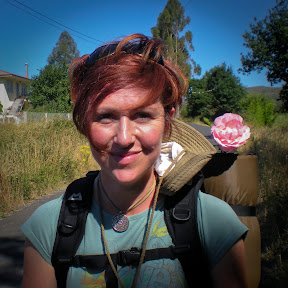
Summer rose
As I arrived Julio was enraged. He and Liz had poked their heads in the door to see what was what and the warden had rushed out screeching for them to get out and that the albergue wasn’t open until one and they mustn’t come in. It takes a lot for Liz to say anything bad about anyone, but she said the woman had been really rude. So we filled our water bottles and decided to keep going. Melide became our next stop, and judging from our found map, there were still 6km to go before we had a chance of finding anything to eat.

I practice my stiff-armed penguin waddle
The path rose towards the Hospital of Seixias (basically the old word for a pilgrim’s rest stop) which was just below a col on a hillside filled with heather and windmills. No bar though. We crossed the border between Lugo and A Coruña at the col and started down. The day was heating up, Julio was complaining about being en yanto, which he explained as equivalent to running on empty but literally means to be on the rims of your wheels (after say, a puncture). He pinched a couple of apples and plums from a tree overhanging the road. The plums were inedibly tart, the apples bitter. I was glad of my doughnut choice in the morning.
We passed another village, asking anyone we met where the nearest bar was. We got differing answers but they all pointed downhill. A chap in a car said we’d find a bar in Vilamor which was 3km ahead. We reached it and gratefully cooled ourselves under a fountain. No bar. We continued and an old boy came out of his house and said another coulple of kilometres, at the end of the village. The vilage was about 3km long. Most annoying. Well eventually (at about 4:30) we got to the bar Carburo and asked what they had. The owner said something about a plato combinado with steak and salad and chips and we said yes. Plus wine and soda. Most welcome, although we sat outside so we were accompanied by significant numbers of flies.
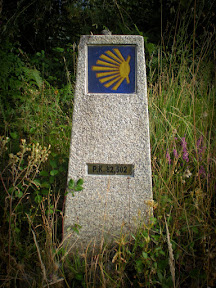
So do they measure the 2cm from the end or the middle?
The steak was big and tender, the chips abundant, the wine homemade, but good, the post prandial snifter of orujo possibly unwise.
The sign on the wall said 55km to Santiago (5km to Melide) but the stone markers we’d been following said 60. Well actually the marker (el mojón) twenty metres up the street said 60.020. They seemed to go in for some serious precision, centimetre level precision. But lacking accuracy. Despite the discrepancy there were still 5km to Melide so we had to get moving, it was 5:45 when we left, there were unlikely to be places in the albergue but we’d just have to see what happened. We sweated past polytunnels filled with flowers until we entered a built up area.
Melide reminded Liz and me of the small towns in rural Argentina, the low rise buildings and the styles of frontage. Not surprising really given that, as the Irish to the US, the Galicians were to Argentina. So much so that pretty much any Spaniard is called a gallego in Argentina. The sounds of the Argentine accent seems to come from Galician too, the x in so many Galician words has lent itself to the sh pronunciation of ‘ll’ and ‘y’.

Liz has had a little bit to drink at this point, and is happy that there's only 55km to go
Sure enough the albergue was full, so we were directed to the sports centre where we were lucky enough to get three of the last four beds (the people who came after us had to sleep on the floor). This was our first contact with the camino frances (the route that most people think of when they think Camino de Santiago). About 1% of pilgrims do the camino primitivo, that’s 2000 so far this year. 75% or more do the camino frances.
In addition to the normal August crowds, this week also included 12,000 young people doing a pilgrimage ending in Santiago on the following Sunday. They, fortunately, were staying in specially reserved sports halls. Our beds were in a walled off area within the sports hall. It was like a temporary military hospital, showers, toilets, dorms of 40 beds walled off. So we showered and marveled at our good fortune and then went out to eat cheese and pimientos de padron (fried green peppers) and drink galician white wine from much bigger porcelain cups than they use in Oviedo.
We strolled happily back to the bunks for the 10 o’clock closing time. I lay on the bed, put my earplugs in and fell asleep in seconds.
Si alguien pudiera hacer unas correcciones si he cometido errores grandes estaría agradecido
Hacía fresco el amanecer al cruce aquel y nos dirigimos al bar para tomar un desayuno de los campeones. Por desgracia este es España así que comimos magdalenas, así comieron Julio y Liz, tomé yo un dónut empaquetado y azucarado. Nos llevó al inicio de la ruta una mujer del hotel en un gran coche familiar que se bamboleaba independientemente de la inclinación de la carretera.
El plan era así, caminar hasta Merlán. Habíamos dejado la planificación detallada gracias a la perdida de la guía, por eso confiábamos en un folleto que lo cogimos el día anterior en la parroquia de San Lazaro. De hecho no sabíamos si había un albergue en Merlán pero la parte segunda del plan era caminar hasta que encuentrásmos algún lugar para comer o pernoctar.
Caminamos, pasando por pueblos pequeñitos y aldeas que consistían de una casa sola. En Galicia los hórreos son de piedra con ladrillos de ventilación o tablillas en los lados, se parecen a nichos individuales (pienso que sería posible poner cuatro cuerpos adentro). Hicimos una parada enfrente de un hórreo mientras nos pasaban lentamente un par de paisanas. Les preguntamos si habían pasado muchos peregrinos hoy, ¡Ay muchos! ¡Muchos! nos contestaron.
Mientras nos sentábamos pasó otra mujer llevando un recipiente lleno de leche con que dio a comer un ternero en un edificio que parecía una ruina. Nos saludamos –La vida rural es un trabajo, nos dijo ella, mucho trabajo, hay que levantarse pronto, trabajo duro. Hicimos ruidos de compasión.
Continuamos, esperando a encontrar un bar en que nos pudiéramos comer algo. Nada. Hablamos con una señora que nos indicó una casa de remedios (una casa privada en que venden cosas a los peregrinos) pero cuando llegamos no hubo ningún respuesta a los gritos de desesperación de Julio como ¡Oiga! ¡Hay alguien¡ y !Remeeeeeedioooooos¡ Un paisano nos dijo que pudiésemos encontrar un bar en Seixas. En aquel momento nos dimos cuenta que estuvimos en Merlán y tendríamos que andar mucho mas que habíamos pensado. En Seixas había un albergue no un bar. Andaban adelante de mi, Julio y Liz (me entretenía) y cuando acerqué al albergue lo vi que era nuevo. Tan nuevo de hecho, que se repartían las camas. Genial, pensé yo, paramos aquí y tener un día fácil.
Al llegar Julio estaba enfurecido. Ellos habían echado un vistazo por la puerta para ver como era y la encargada había venido gritando que se vayan y que no estaba abierto hasta la una y que sea prohibido entrar. Liz no dice normalmente nada mala sobre la gente pero dijo que la encargada era mal educada (Julio dijo repugnante). Así que las llenamos las cantimploras y nos decidimos a continuar. Melide se convirtió en la parada próxima y segun el mapa que teníamos nos quedaron 6km antes de tener la opción de comer.
Subía el camino hacia el hospital de Seixas que se localizaba abajo de un collado en una ladera llena de brezo y molinos de viento. No había ningún bar. Cruzamos el limite entre Lugo y A Coruña por el collado y empezamos a bajar. El día continuaba haciendo calor, Julio se quejaba de ser en yanto que nos explicó que significa tener un hambre fuerte. Robó unas manzanas y ciruelas que sobresalían la carretera. No pudimos comer las ciruelas por la acidez, las manzanas sí, aun que quedaron amargas. Estaba agradecido por los dónuts de la mañana.
Pasamos por otro pueblo preguntando –donde esta el bar mas cerca, a cualquier persona que encontramos. Recibimos respuestas distintas pero siempre abajo. Un paisano en un coche nos dijo que encontraríamos un bar en Vilamor a 3km. Llegamos al pueblo y refrescamos agradecidamente en una fuente. No había un bar. Continuamos y un hombre salió de su casa y nos dijo dos kilómetros mas, a los finales del pueblo. El pueblo extendía unos 3km. Qué frustrante. Al final llegamos al bar Carburo y los preguntamos para lo que tuviesen. El dueño dijo algo sobre su plato combinado, ternera, ensalada y patatas fritas y dijimos que sí. Mas vino y casera. Fue un placer a pesar de sentarnos afuera acompañado por muchas moscas.
La ternera fue grande y tierna, las patatas fueron abundantes, el vino era de la casa pero bueno, el orujo fue posiblemente poco prudente
Una indicación en la pared decía 55km hasta Santiago (5km a Melide) pero los mojones que habíamos estado siguiendo decían 60. Bueno, el mojón que estaba allí a los 20m arriba decía 60,020. Les gusta ser preciso hasta la nivel de los centímetros. Pero sin exactitud. A pesar de la diferencia todavía nos quedaron 5km hasta Melide así que marchamos. Eran las 17:45h cuando salimos, no era probable que nos quedaría lugar en el albergue pero tendríamos que ver. Pasamos con un sudor por al lado de unas invernaderos llenos de flores hasta que entramos en un barrio residencial.
A Liz le recordaba Melide a los pueblos pequeños de Argentina, por los edificios bajos y las fachadas. Eso no era sorprendente porque como son los irlandeses en los EE.UU son iguales los gallegos en Argentina. Tanto que los españoles allí se llaman ‘gallegos’. Los sonidos del acento argentino quizás originan de Galicia también, la x en muchas palabras gallegas parece la fuente de los sonidos ‘sh’ de las ‘ll’e ‘y’ en Argentina.
Cierto, era lleno el albergue entonces nos indicaron al polideportivo donde cogimos tres de las ultimas cuatro plazas por suerte (los que venían detrás de nosotros tenían que dormir en el suelo). Era el primer contacto con el camino francés (el camino en que piensan la mayoría de la gente cuando piensan del caminos de Santiago). Alrededor de 1% de los peregrinos hacen el camino primitivo, 2000 hasta ahora este año. 75% o más hacen el camino francés.
Ademas de la muchedumbre normal para agosto, esta semana hacían el camino 12.000 jóvenes terminando en Santiago el domingo siguiente. Afortunadamente quedaban en pabellones especiales. Las camas nuestras estaban en una área con paredes adentro del polideportivo. Era como un hospital militar con duchas, dormitorios para 40 personas detrás de las paredes. Duchamos y nos maravillamos con la suerte que tuvimos. Salimos para comer queso, pimientos de padrón y beber vino blanco de Galicia de tazas mucho mas grandes que las que utilicen en Oviedo.
Paseamos feliz a las literas antes de la hora de cerrar (las 22h). Me eché en la cama, puse los tapones y me dormí enseguida.



